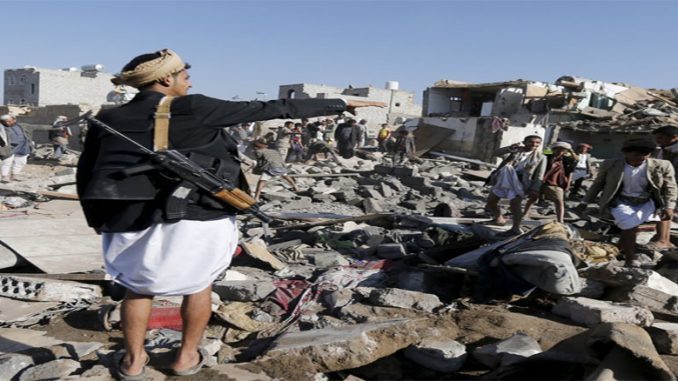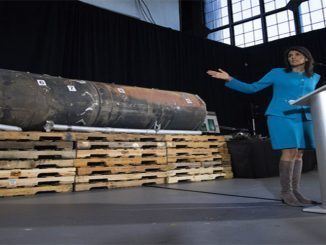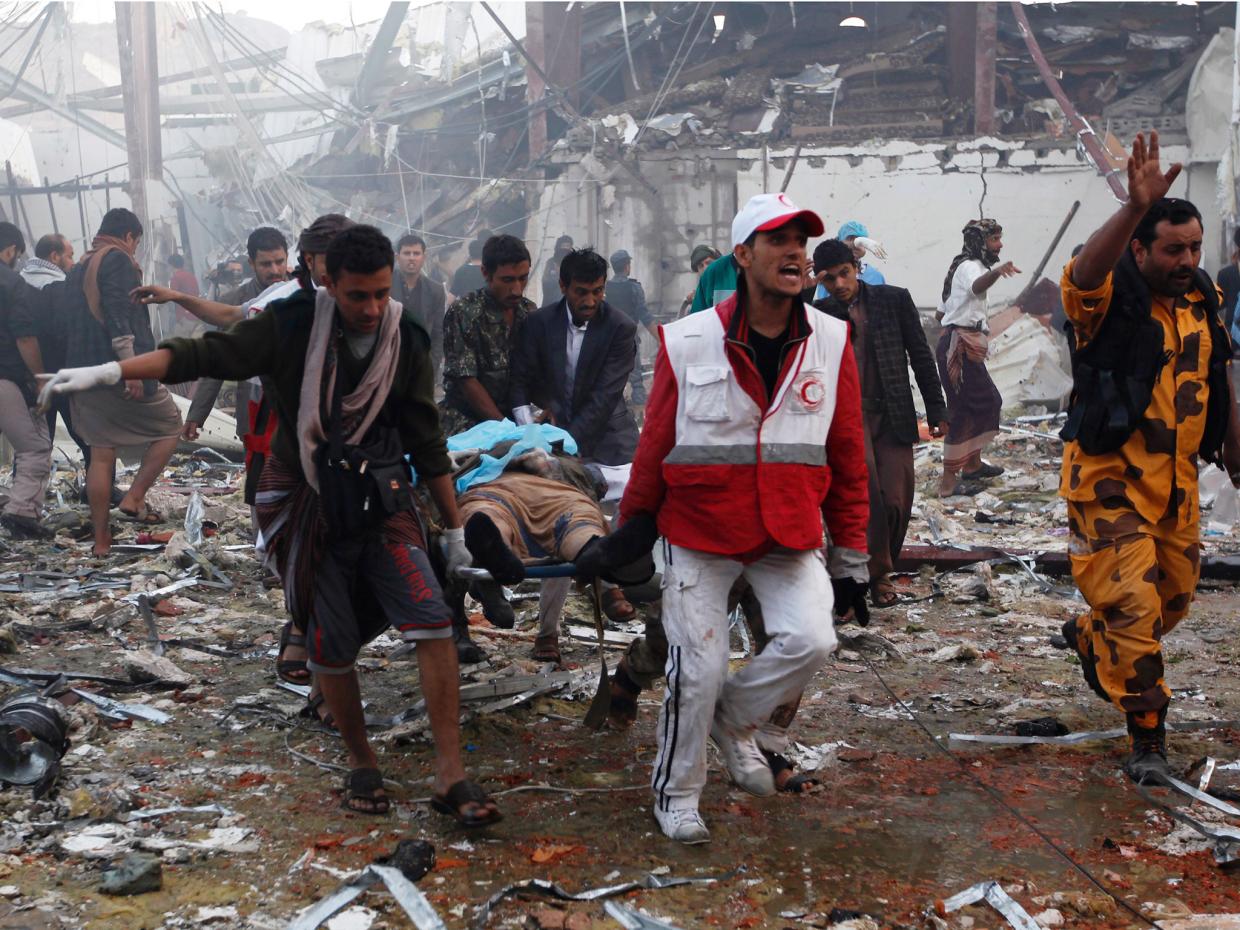
Ironically enough, almost the same countries which had supported Egypt’s military coup against the country’s legitimate government and its first democratically elected President Mohamed Morsi, launched in 2015 Operation Decisive Storm against the Houthi militants in Yemen to restore the legitimate government of the internationally-recognized but domestically opposed President Abdrabbuh Mansur Hadi..
Saudi Arabia decided to enter Yemen’s war heading a coalition of nine Arab and African states on March 26, 2015, in order to roll back Al Houthi gains and restore Hadi’s power.
The coalition member-states included Saudi Arabia, the United Arab Emirates, Kuwait, Bahrain, Qatar, Sudan, Egypt, Jordan, and Morocco. However, Pakistan and Somalia voiced support to the coalition while the United States provided logistical and intelligence support to the strikes against the Houthis.
Deadly fighting, a rise in extremism, the threat of famine – two years after Saudi Arabia intervened against the Houthi rebels, Yemen is more unstable than ever.
The intervention of the Saudi-led coalition initially consisted of a bombing campaign on Houthi rebels and later saw a naval blockade and the deployment of ground forces into Yemen. The coalition attacked the positions of the Houthi militia and loyalists of the former President of Yemen, Ali Abdullah Saleh, supported by Iran, in response to a request from the internationally-recognized but domestically opposed government of President Abdrabbuh Mansur Hadi.
Fighter jets and ground forces from Egypt, Morocco, Jordan, Sudan, the United Arab Emirates, Kuwait, Qatar and Bahrain also took part in the operation. Djibouti, Eritrea and Somalia made their airspace, territorial waters and military bases available to the coalition.
The United States provided intelligence and logistical support, including aerial refueling and search-and-rescue for downed coalition pilots. It also accelerated the sale of weapons to coalition states. US and Britain have deployed their military personnel in the command and control centre responsible for Saudi-led air strikes on Yemen, having access to lists of targets.
Yemen’s war has killed more than 10,000 people and wounded 42,500 others since a Saudi-led Arab coalition intervened in support of the government two years ago.
The conflict underscores the regional rivalry between Iran which backs Al Houthi rebels and Saudi Arabia, which heads the nine-member Arab coalition fighting to restore the presidency of Hadi.
Timeline for ‘Operation Decisive Storm’
On March 26, 2015, the coalition launched operation “Decisive Storm” with airstrikes against Houthi rebels to defend embattled President Abedrabbo Mansour Hadi, who sought shelter in Riyadh.
The Sunni coalition also comprises the Gulf monarchies Bahrain, Kuwait, Qatar and the United Arab Emirates along with Egypt, Jordan, Morocco and Sudan.
A month later, it is rebranded the operation “Restoring Hope”.
The goal was to defeat the rebels who have controlled the capital since September 2014 in addition to large swathes of land in northern, central and western Yemen.
On July 17, 2015, the government announced the liberation of southern Aden province after more than four months of fighting.
In August 2015, the coalition supplemented its air power with hundreds of ground troops.
By mid-August, loyalist forces retook the south, but faced a growing presence of fighters from al-Qaeda and the Islamic State group.
In February 2016, Riyadh said loyalist forces controlled “more than three quarters” of Yemen, despite trouble advancing in the southwestern province of Taiz and in Marib, central Yemen.
Three months of UN-brokered peace talks in Kuwait end in stalemate, and coalition aircraft resume strikes on Sanaa on August 9, 2016.
On January 7, 2017, pro-government troops backed by coalition planes and ships launch operation “Golden Spear” around the strategic Bab al-Mandab Strait, between the Red Sea and the Gulf of Aden.
Failed ceasefires
The UN and US organise three rounds of fruitless peace talks, in June and December 2015 in Switzerland and in April 2016 in Kuwait.
Seven truces are agreed, but all broken.
The severing in January, 2016 of diplomatic relations between Saudi Arabia and Iran complicates the task for diplomats.
The internationally-recognised government, led by Hadi, establishes a “provisional” base in the port city of Aden in late September 2016.
Two months later, the rebels and allied forces of former president Ali Abdullah Saleh form a government of their own in Sanaa, dousing hopes of a UN-brokered national unity government.
Carnage
On September 28, 2015, an airstrike smashes a wedding hall in southwestern Mokha, killing 131 people. The coalition denies responsibility.
On August 15, 2016, coalition planes bomb a hospital in Abs, northwestern Yemen, the fourth strike in a year on a medical facility run by the non-governmental organisation Medecins Sans Frontieres (Doctors Without Borders). MSF says 19 people died and 24 were wounded.
Coalition planes have dropped banned cluster munitions and killed two times more civilians than other forces, according to the UN.
On October 8, 2016, an airstrike kills 140 people and wounds 525 others at a funeral in Sanaa. The coalition belatedly acknowledges responsibility.
Washington steps up airstrikes against al-Qaeda in the Arabian Peninsula (AQAP), which has benefitted from the chaos to gain influence.
AQAP loses territory to the Islamic State which on March 20, 2015 claims responsibility for the first time for attacks against two Shia mosques in Sanaa that kill 142 people.
A botched January 29 anti-AQAP raid by US special forces results in the deaths of a US Navy SEAL and multiple civilians – including women and children.
Famine
According to the UN, the fighting has displaced more than three million people, and more than two thirds of Yemen’s population of around 18.8 million people need aid.
Some 7.3 million people are estimated to be close to starvation and 462,000 children suffer from serious malnutrition. Without $2.1 billion in international aid, the UN warns that Yemen will suffer a famine in 2017.
***
The war in Yemen has received widespread criticism and had a dramatic worsening effect on the humanitarian situation, that reached the level of a “humanitarian disaster”.
The de facto blockade left 78% (20 million) of the Yemeni population in urgent need of food, water and medical aid. Aid ships are allowed, but the bulk of commercial shipping, on which the country relies, is blocked.
More than 2,500,000 people have been internally displaced by the fighting. Moreover, many countries evacuated more than 23,000 foreign citizens from Yemen. More than 1,000,000 people fled Yemen for Saudi Arabia, Djibouti, Somalia, Ethiopia, Sudan and Oman.



